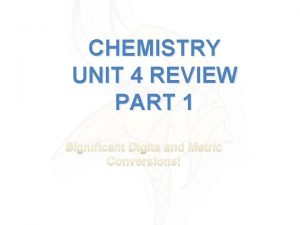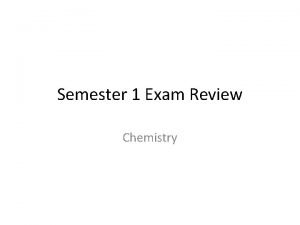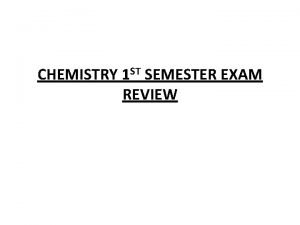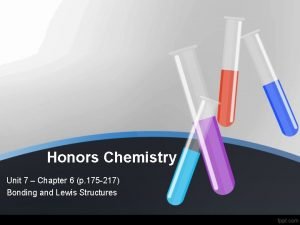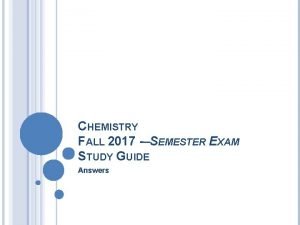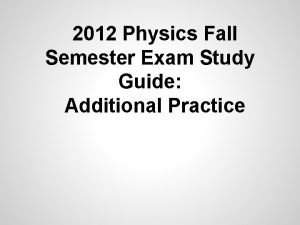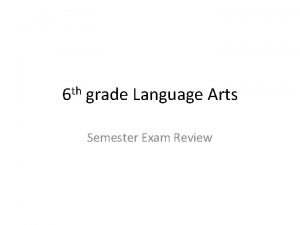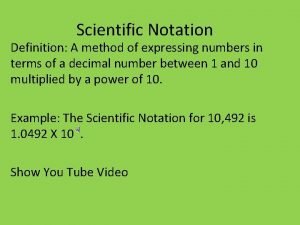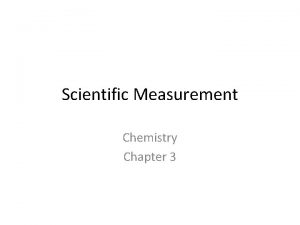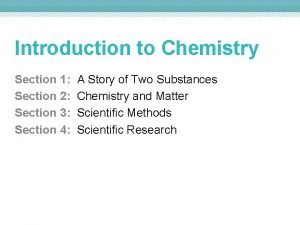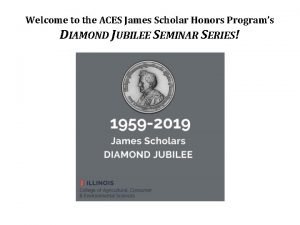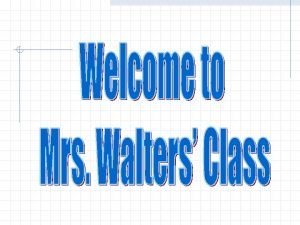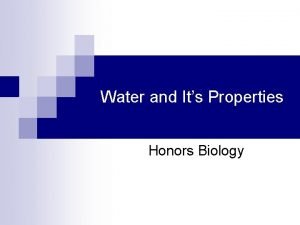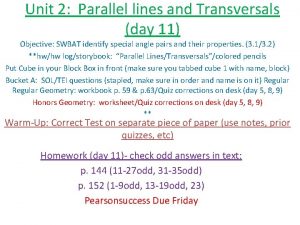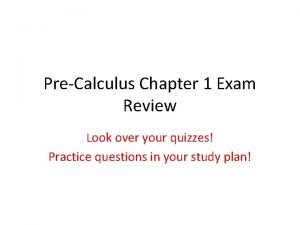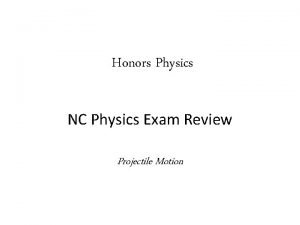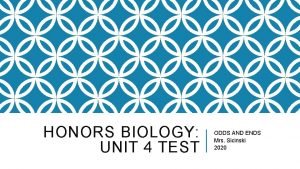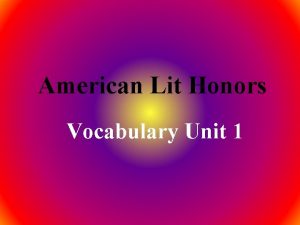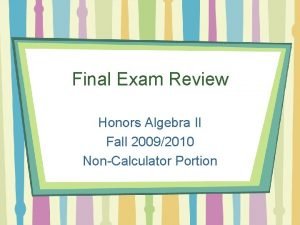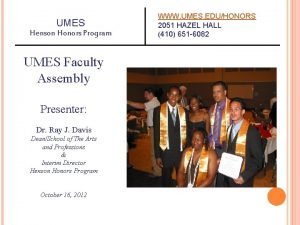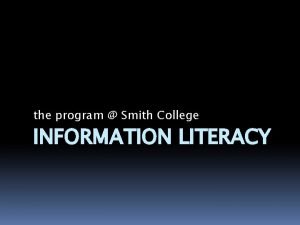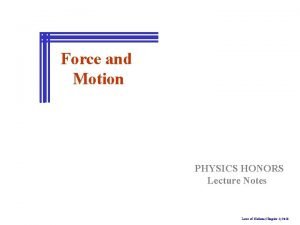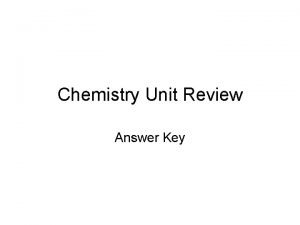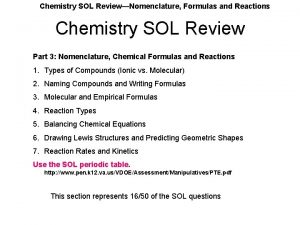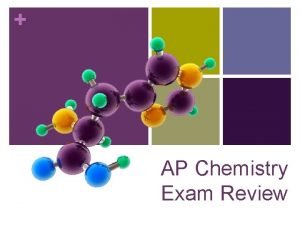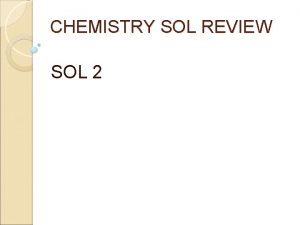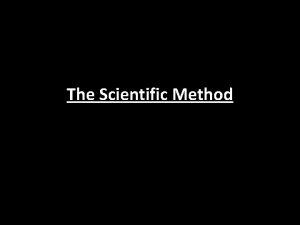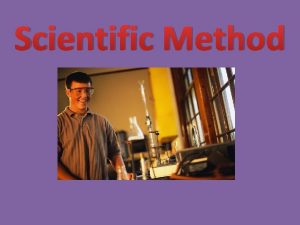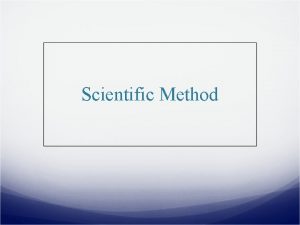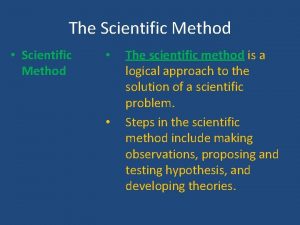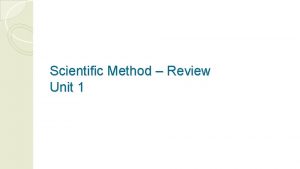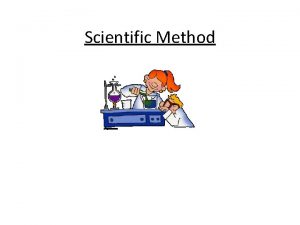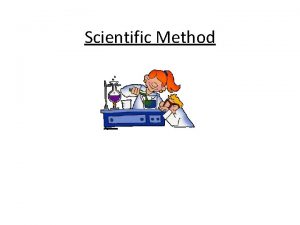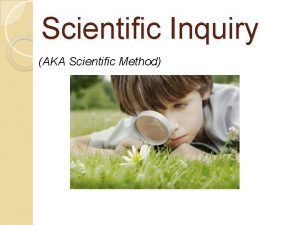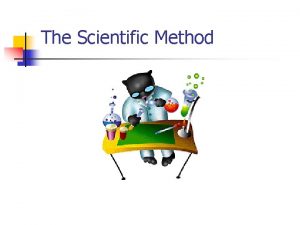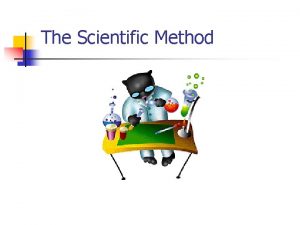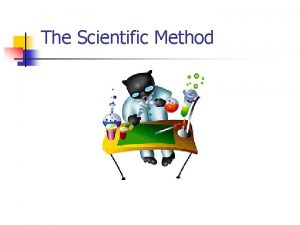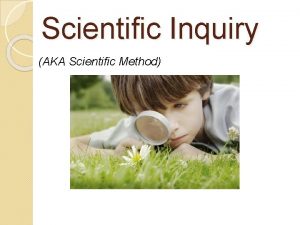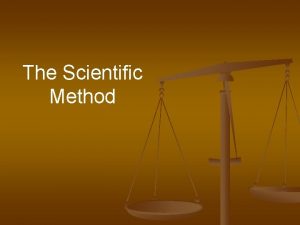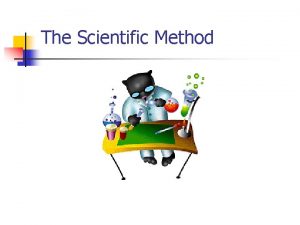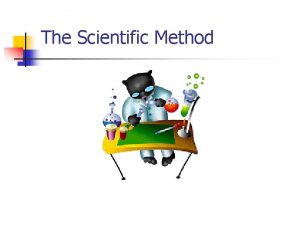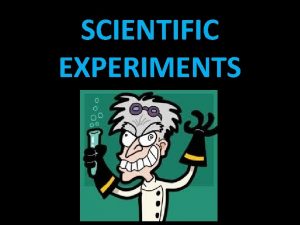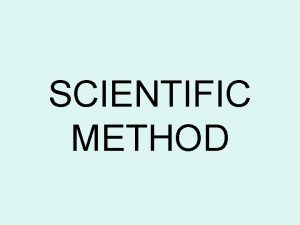Honors Chemistry 1 st Semester Review Scientific Method













































































- Slides: 77

Honors Chemistry 1 st Semester Review

Scientific Method - Observe • Observation – the receiving knowledge or data through the senses, or from scientific instruments • Inferences – Assumptions based on observations. • Example: – Observation: Car won’t start in the morning. – What would you assume (or infer) the problem is?

Scientific Method - Observe Observations: • 1. Qualitative – Do you like this powerpoint? • Usually uses the five senses. • 2. Quantitative – How many words are on this powerpoint? • Usually can be answered precisely.

Scientific Method - Hypothesis : a statement that answers a question (a possible explanation) Tells what are the independent and dependent variables and how to measure them.

How do Scientists Communicate? By sharing information. -Poster sessions -Presentations at conferences/meetings -Scientific Journals -Shared Data Bases - Internet What happens when scientists disagree? Scientific arguments are solved through further observation and experimentation

To reveal data trends, data is placed in graphs Time (min) Temp. (˚C) 0 0 1 0 2 0 3 5 4 10 5 15 6 20 7 25 8 25 9 30 10 30

Finding Volume of Irregularly shaped items n This is called Water Displacement

The Graduated Cylinder Measures Volume n Start by locating the meniscus n Always make your reading at the bottom of the meniscus!!

Finding Density is a ratio between mass and volume. n You need to divide to find the ratio. n Density = mass divided by volume OR n D = M/V n

Electronic Balance Measures Mass Turn balance on n Make sure it reads “ 0” n Place item on balance n Obtain mass n Turn balance off n n SI Unit for mass is the kg

Syllabus What is Chemistry? Chemistry is the study of matter and energy and the interactions between them. Chlorine – gas will kill you Sodium – metal reacts violently with oxygen It is stored in oil. Sodium + Chlorine = Table Salt which our bodies need

Pure vs. Applied Science • BOTTOM LINE: • Pure Science is just for the knowledge. • Applied Science is for someone to make money off of the invention (new technology)

What IS science based on? • Experimentation • Observation

Rules for significant figures: (1) All nonzero digits are significant (1 -9): 1. 234 g has 4 significant figures 1. 2 g has 2 significant figures (2) Zeroes between nonzero digits are significant: 1002 kg has 4 significant figures 3. 07 m. L has 3 significant figures (3) Leading zeros (left) of the first nonzero digits are NOT significant; They indicate the position of the decimal point: 0. 001°C has only 1 significant figure 0. 012 g has 2 significant figures

(4) Trailing zeroes (after a decimal point) are significant: 0. 0230 m. L has 3 significant figures, 0. 20 g has 2 significant figures. (5) When a number ends in zeroes that are not to the right of a decimal point, the zeroes are not necessarily significant: 190 miles may be 2 or 3 significant figures 50, 600 calories may be 3, 4, or 5 sig figures • The potential ambiguity in the last rule can be avoided by the use of standard exponential, or "scientific, " notation.

• What is an "exact number"? • Some numbers are exact because they are known with complete certainty. • Most exact numbers are integers: exactly 12 inches are in a foot, there might be exactly 23 students in a class. • Exact numbers are considered to have an infinite number of significant figures.

• Rules for mathematical operations • In calculations, the general rule is that the accuracy of a calculated result is limited by the least accurate measurement involved 1) In addition and subtraction, the result is rounded off so that it has the same number of digits as the measurement having the fewest decimal places (counting from left to right). For example, 101 (3 sig figures) + 23. 643 (5 sig figures) = 124. 643, which should be rounded to 125 (3 sig figures). 302. 1 + 54. 345 = 356. 445, which should be rounded to 356. 4 (least shared decimal place)

2) In multiplication and division, the result should be rounded off so as to have the same number of significant figures as in the component with the least number of significant figures. For example, 3. 0 (2 sig figures ) × 12. 60 (4 sig figures) = 37. 8000 which should be rounded to 38 (2 sig figures).

Temperature Converting • ºC = K – 273 between ºC • K = ºC + 273 and K Example • Normal human body temperature is 37 ºC. What is your temperature in K? Practice • Surgical instruments must be sterilized at 170 ºC. What is this in K?

Physical and Chemical Changes Physical Changes: Do not alter the identity of a substance ¡ Crushing, tearing, changes of state (solid to liquid to gas) Chemical Changes: Alter the identity or chemistry of a substance ¡ Burning, cooking, rusting

What is Matter? ¡ Matter is anything that has mass and volume

States of Matter Liquid ¡ has undefined shape but defined volume ¡

Pure Substances – Element n n Matter that can not be broken down into simpler substances under normal lab conditions Contains only one kind of atom Atom Molecule Elements (symbols) Na, Au, C Where can you find a list of all the elements?

Mixtures: Homogeneous n n n Mixture with no visibly different parts. Sea water - H 2 O + Na. Cl Air - N 2 + O 2 + CO 2

Physical and Chemical Changes ¡ ¡ Is this a physical or a chemical change? Explain your reasoning. New substances form when there is a chemical change.

� J. J. Thomson � 1897 Experiment � - discovered electrons � Atom is made up of charged matter

� Ernest Rutherford: � 1910 – Planetary Model � Atom is mostly empty space � Found the nucleus (a small dense region of positively charged particles). � If the nucleus were the size of a marble, � Then the atom would be the size of Cardinal’s stadium � Theorized about the neutron – not proven until 1932


� John Dalton – 1808 Atomic Theory: 1. Elements are made up of tiny particles called atoms. 2. Atoms of one element are identical. 3. Atoms of other elements are different from each other. 4. Atoms can combine to form compounds. 5 Atoms are not created, nor destroyed, but can change they way they are grouped together.

Periodic Table Trends The most important difference between Mendeleev's table and today’s table: the modern table is organized by increasing atomic number, not increasing atomic weight. Why was the table changed? Discovery of isotopes and ions.

Atomic Number = Number of Protons � Hydrogen – 1 proton = #1 � Helium – 2 protons = #2 � Gold – 79 protons = #79 � Rules: All elements on the period table are neutral. � Therefore, #of protons = #of electrons � What about neutrons – we’re coming to that later

Periodic Table Trends Groups – Columns Elements within a group share several common properties. Groups have the same outer electron arrangement. Like families, the share the same characteristics

Periodic Table Trends Metals Most of the elements are metals. You see metals every day. Aluminum foil, gold, silver. If someone asks you whether an element is a metal, metalloid, or non-metal and you don't know the answer, guess that it's a metal. Properties of Metals lustrous (shiny) malleable (can be hammered) good conductors of heat and electricity

Periodic Table Trends Group 18: Noble Gases Helium and neon are examples of noble gases. These elements are used to make lighted signs, refrigerants, and lasers. The noble gases are not reactive. He Never Argued with Superman Xenon’s a Nurse.

Periodic Table Trends Group 17: Halogens (Examples of halogens are chlorine and iodine. ) You find these elements in bleaches, disinfectants, and salts. highly reactive.

What does this mean and why do we care? l Properties of atoms correlate with the number and energy of electrons l Atoms like to have full outer shells l Valence electrons have the most energy (this is where all the action occurs) l This will help us predict what reactions may occur when we start mixing elements together

Main Group Elements & Their Ions Note periodicity of charges

Periodic Table – Long Form

� Atomic # = # of Protons � Symbol Atomic Mass

Isotopes: elements with a different number of neutrons. � Elements have to have the same number of protons to be the same element.

�Mass Number �Protons �Neutrons �NOT Electrons (too small to want to count)

� Atomic mass Review: � What does one proton weigh? � 1 atomic mass unit (amu) � What does one neutron weigh? � 1 amu � What does one electron weigh? � So small we will consider it to be zero

� Atomic # = # of Protons � Symbol What is this?

Why the weird number? We know that Lithium has 3 protons 3 amu We assume it has 3 neutrons 3 amu We assume the electrons are zero mass. So we total 6 amu. Where is the 0. 941 coming from? Isotopes 6. 941 is the average of all the naturally occurring isotopes of lithium.

Li-, Mg 2 - Cu 2+, F+

Main Group Elements & Their Ions Note periodicity of charges

Isotopes: elements with a different number of neutrons. � How do we write isotopes? 14 C

Transition Metals Noble Gases Halogens Chalcogens Alkaline Earth

Periodic Table Trends Nonmetals upper right side of the periodic table (Yellow) The halogens, the noble gases, and the rest. Poor conductors of heat and electricity. Solid nonmetals are brittle and lack metallic luster.

l Hund’s Rule: electrons will not share an orbit until needed

White Board Practice Lewis Symbols or Lewis Dot Diagrams • We place the electrons on four sides of a square around the element symbol. Practice: O Na Ca Ba Ne H I Cs • Check with your partner

Shorthand l If it is in a row past a noble gas, we can use that for a shortcut. Short-hand Notation l [Ne] 3 s 1 l l [Ar] 4 s 2, 3 d 1 l [He] 2 s 2, 2 p 5

Energy Notes Energy – Capacity to do work or produce heat – Capacity to move or change matter

Types of Energy Potential • Stored – Energy of position (water wheel, book on shelf) – Chemical energy (gas, food, batteries) Kinetic • Motion – Mechanical energy (moving parts of machines) – Sound: vibration of molecules • Radiant (EMR) Thermal energy (Sun’s heat) Light

ENERGY • Energy can be converted from one form to another. • Law of Conservation of Energy: • energy is not created nor destroyed, but can CHANGE from one form to another.

• 3 examples of Chemical Energy.

l ROYGBIV – backwards – R least energy

Wednesday – October 24 • Rube Goldberg Poster – Presentations

How do atoms release Energy In energy? Energy Out

Heat and Temperature Exothermic • System that releases energy into its surroundings • Release energy because a change has occurred • Combustion reactions Endothermic • System that takes energy in as heat from the surroundings • Needs energy from outside source in order for a change to occur • Changing water to steam Or melting ice

How do we measure energy? SI Unit: Joule (J) 1 Calorie = amount of energy required to raise 1 g of water by 1°C 1000 cal = 1 kilocalorie = 1 Cal = food Calories Conversion Factor 1 calorie = 4. 184 Joules

Calculating Energy Specific Heat Capacity or Specific Heat: The amount of energy required to change the temperature of 1 g of substance by 1 C Units are: J (Joule) g C Centrigrade NOT Calories It takes different amounts of energy to heat different substances.

Phase Diagram - Overview

Phase Change diagram Exothermic Endothermic What definition are we missing? sublimation deposition

Q= m. C T • Example 4 • Practice 4 • What is the specific heat of lead if a 30. 0 g piece of lead undergoes a 250ºC change while absorbing 229. 5 calories? • 0. 0306 cal/gºC = sigfigs? • 3. 06 x 10 -2 cal/gºC • What is the specific heat of an unknown substance if the addition of 950 J of heat energy caused a 20 gram sample to warm from 18ºC to 42ºC? 1. 97 cal/gºC = sigfigs? 2. 0 cal/gºC

Writing Formulas for Ionic Compounds • Crisscross • Write the element symbols for the cation Method anion, with the cation on the left and the anion on the right. • Write each ion’s charge as a superscript. • Crisscross the two charges moving them downward diagonally from one superscript to the other subscript. • Example

Naming Binary Ionic Compounds Name Formula Example: Calcium Chloride Ca +2 and Cl -1 Ca. Cl 2 1. Identify the ions involved 2. List the cation first and then the anion 3. Determine that charge of each ion involved 4. Balance the charges so the compound is neutral.

Naming Binary Covalent Compounds Prefixes 1= mono (can be omitted – assumed) 2= di 3 = tri 4 = tetra 5 = penta 6 = hexa 7 = hepta 8 = octa 9 = nona 10 = deca

Naming Binary Covalent Compounds Practice Name Formula What is the formula for the following compounds? 1. Write the chemical formula of the first element listed. 2. Write the prefix number as a subscript. 3. Write the chemical formula of the second element listed. 4. Write the prefix number as a subscript. a. Pentachlorine dioxide b. Carbon monoxide c. Tribromine hexasulfide

Naming Binary Covalent Compounds Practice Formula Name 1. Write the number of the first element as a prefix, add the name of chemical. 2. Write the number of the second element as a prefix, add the name of chemical and end in –ide. What is the name of the a. P 4 C 8 following b. F 9 I 6 compounds? c. SN 3

Properties of Covalent Bonds • • Solids are usually soft low melting points low boiling points Properties arise because molecules are not strongly held together • Usually found with nonmetals

Properties of Ionic Bonds • Ionic bonds are very strong (separating ions requires lots of energy) • High melting points, boiling points • Crystals are hard and brittle • Electrical insulators when solid, electrical conductors when molten or dissolved in water • Between a metal and a non-metal

Why do atoms form bonds? Octet Rule Atoms tend to gain, lose, or share electrons in order to acquire a full set of valence electrons. Lewis Dot Diagrams • Used to illustrate valence electrons • Used to illustrate how electrons rearrange during chemical reactions (when bonds are formed or broken)

Review: Ions • What are Ions? • Ions are formed by adding or subtracting electrons from a neutral atom or molecule. Cation: positive charge Anion: negative charge (remove electrons) Na+ (add electrons) Cl-

Naming Binary Covalent Compounds Practice Formula Name 1. Write the number of the first element as a prefix, add the name of chemical. 2. Write the number of the second element as a prefix, add the name of chemical and end in –ide. What is the name of the a. P 4 C 8 following b. F 9 I 6 compounds? c. SN 3

ORGANIC • In Chemistry, Organic means it has a carbon atom in it. • Question: can there be an organic ion? NO – carbon does not form ions. • Can there be organic covalent bonds? YES – all carbon bonds will be covalent and therefore they will be organic.

Carbonated Drinks • • Carbonate: special group of polyatomic ion CO 32 What kind of Ion does It need to balance? 2+ like what family? Alkaline Earth Metals How many Carbon molecules? 1
 Physics semester 1 review
Physics semester 1 review What is the answer
What is the answer Chemistry semester 2 review unit 12 thermochemistry
Chemistry semester 2 review unit 12 thermochemistry Chemistry semester 1 exam study guide answers
Chemistry semester 1 exam study guide answers World history semester 1 final exam study guide answers
World history semester 1 final exam study guide answers Chemistry first semester exam review
Chemistry first semester exam review Kuei honors chemistry
Kuei honors chemistry Honors chemistry summer assignment
Honors chemistry summer assignment No3 polarity
No3 polarity Scientific inquiry vs scientific method
Scientific inquiry vs scientific method If a laboratory fire erupts, immediately
If a laboratory fire erupts, immediately World history semester 2 final review packet
World history semester 2 final review packet World history fall semester exam review
World history fall semester exam review Us history final semester 2 review
Us history final semester 2 review Algebra 1 final review packet
Algebra 1 final review packet Zoology final exam review
Zoology final exam review Geometry unit 5 review
Geometry unit 5 review Apes semester 1 review
Apes semester 1 review Physics fall semester review answers
Physics fall semester review answers Us history final exam study guide
Us history final exam study guide English 3 fall semester exam review
English 3 fall semester exam review Ironydef
Ironydef Biology semester 1 review 2018
Biology semester 1 review 2018 World history 1st semester final review answers
World history 1st semester final review answers How is a scientific law different from a scientific theory?
How is a scientific law different from a scientific theory? Scientific notation definition
Scientific notation definition 3 scientific measurement
3 scientific measurement Vce chemistry practical investigation
Vce chemistry practical investigation Introduction to chemistry section 3 scientific methods
Introduction to chemistry section 3 scientific methods Creighton university honors program
Creighton university honors program James scholar honors program
James scholar honors program Deped order no. 36 s. 2016
Deped order no. 36 s. 2016 Frap ucsb
Frap ucsb Honors biology ecology test
Honors biology ecology test Uncle sam's toolbox assignment answers
Uncle sam's toolbox assignment answers Quadrilateral test review
Quadrilateral test review Honors earth science
Honors earth science Honors math 3
Honors math 3 Hilton honors military program
Hilton honors military program Honors project
Honors project Honors biology properties of water lab
Honors biology properties of water lab Honors geometry parallel lines and transversals worksheet
Honors geometry parallel lines and transversals worksheet Tulane honors program
Tulane honors program Second quarter exam
Second quarter exam Precalculus honors chapter 1 test
Precalculus honors chapter 1 test Honors physics projectile motion test
Honors physics projectile motion test Honors biology unit 4 test
Honors biology unit 4 test Smc scholars classes
Smc scholars classes Golden opulence sundae
Golden opulence sundae Math 3 honors
Math 3 honors Amorphous vs crystalline
Amorphous vs crystalline Algebra 1 honors
Algebra 1 honors Mahurin honors college
Mahurin honors college Honors algebra 2 final exam
Honors algebra 2 final exam Umes honors program
Umes honors program Latin honors smith college
Latin honors smith college Pathfinder shooting star
Pathfinder shooting star Physics honors notes
Physics honors notes Ib chemistry functional groups
Ib chemistry functional groups Inorganic vs organic chemistry
Inorganic vs organic chemistry Importance of symposium in education
Importance of symposium in education Coherent literature review
Coherent literature review Scientific notation review
Scientific notation review Chapter 9 review stoichiometry section 3
Chapter 9 review stoichiometry section 3 Chemical formula of love
Chemical formula of love Chapter 14 acids and bases
Chapter 14 acids and bases Modern chemistry chapter 13 review answers
Modern chemistry chapter 13 review answers Modern chemistry chapter 12 review answers
Modern chemistry chapter 12 review answers Grade 9 chemistry review
Grade 9 chemistry review Geometry sol review packet
Geometry sol review packet Chemistry unit review answer key
Chemistry unit review answer key Kuhinjska sol formula
Kuhinjska sol formula Chapter 8 review chemical equations and reactions
Chapter 8 review chemical equations and reactions What functional group is ch3
What functional group is ch3 Chapter 22 review organic chemistry section 1 answers
Chapter 22 review organic chemistry section 1 answers Ap chemistry big idea 6 review answers
Ap chemistry big idea 6 review answers Ap chemistry big idea 2 review answers
Ap chemistry big idea 2 review answers Chemistry sol review
Chemistry sol review

